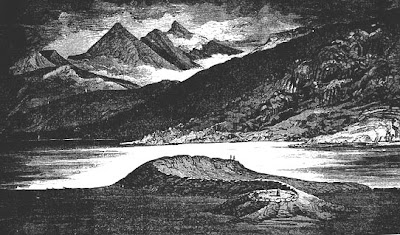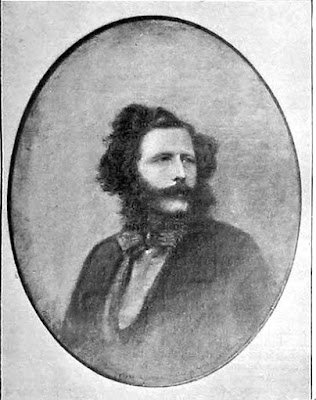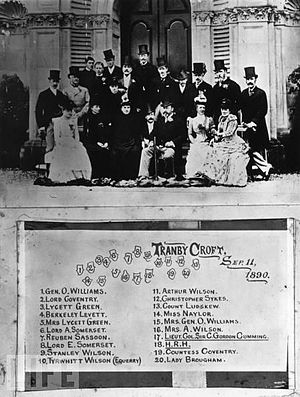CONSTANCE
FREDERICA GORDON-CUMMING 1837 - 1924
The
British Empire in the 1860’s spawned a surprising number of adventurous and
independent women. This was a time when the suffrage movement was still only a
remote dream. A time when women were
subject to their husbands and fathers bidding; a time when ladies were
chaperoned and rarely ventured too far from home.
For a woman of gentle upbringing solo travel
abroad was unthinkable. Two such independent women spring to mind, Isabella
Bird who thought nothing of donning men’s trousers to cross the American
Rockies and was reputed to have hunted lions, and Marianne North the renowned
botanical painter who traversed the world in search of rare specimens.
There
was though another who broke the mould.
Another who forged a friendship with both Bird and North and who
equalled and probably surpassed both ladies with her travels to remote
destinations, prolific paintings and her numerous books.
Over
the centuries this lady’s life has been largely forgotten. I would never have known she even existed had
I not been researching my great grandmother’s life in Fiji and discovered the
artwork and autobiographical travelogues of Lady Constance Frederica
Gordon-Cumming, Scotland born daughter of a Baronet from Northumberland.
 |
|
Lady
Gordon-Cumming 1893 by Herbert Rose Barrund (National Portrait Gallery)
|
I
stumbled on the lady while trawling the net for more background information
about Fiji’s first colonial Governor Sir Arthur Gordon, a gentleman to whom she
was not related. A fact I thought an astonishing coincidence considering they
shared a surname.
Well
not quite. Actually Constance Frederica’s
family name, the double barrelled Gordon-Cumming was first established when a
12th century Scot, John 2nd
Comyn, Lord of Badenoch married Eleanor, sister of King John of Scotland,
and one of their future progeny married Lucy
daughter of Sir Ludovic Gordon of Gordonstoun: Their family becoming known
as the Cumming-Gordon’s.
Then
a future Baronet from this union became a Member of Parliament and for whatever
reason reversed the family name to read Gordon-Cumming.
In
fact I rather think the Gordon-Cumming family were sticklers for formality
because Constance Frederica insisted she be addressed by her full and entire
surname and, as one Governor’s equerry observed, “Woe befall the casual
acquaintance who addresses her as ‘Miss
Cummins’”.
___
Constance
was born in 1837 to the 2nd Baronet Sir William Gordon-Cumming and
his first wife Elizabeth Maria Campbell, which made her 38 years of age when
she visited Fiji. At that age I guess
you could say she was to her many nieces and nephews their maiden aunt.
I
think the Fiji Governor’s equerry described her appearance rather unkindly but
exceedingly well… “Miss Gordon Cumming is
a very tall plain woman, a regular globe-trotter, wonderfully good-tempered,
has no tact, is very pushing when she wants anything done, and yet is one of
the best natured creatures in the world, and when anyone is ill or wants help I
believe she would go any distance out of her way to help them.”
Constance
or “Eka” as close friends and relations called her, was one of the 2nd
Baronet’s 12 children, and adventure and the love of travel was also evident in
her brother, Sir William’s second son (who of course didn’t inherit the
Baronetcy) Roualeyn Gordon-Cumming, himself a well travelled African
explorer.
A
line of verse penned by his sister shows her obvious admiration, tinged perhaps
with an edge of jealousy…
Ah! Who like the Cumming – in valour the peerless
With the heart of a lion, yet a lamb at the core;
The Nimrod of Afric, the dauntless, the fearless,
Earth hath not thy patter – Roualeyn no more.
With the heart of a lion, yet a lamb at the core;
The Nimrod of Afric, the dauntless, the fearless,
Earth hath not thy patter – Roualeyn no more.
So
obviously did Constance Frederica hero worship her brother, I couldn’t help
wondering how she felt about their older brother’s son, nephew Lt Col Sir
William Gordon-Cumming who in 1866 at the age of 18 inherited the title of 4th
Baronet.
(All very sad, after all, the lad’s father, Eka’s sibling had first to
die.)
This
William led both an adventurous and an infamous life. He fought in the Anglo-Zulu War in Africa,
was shipwrecked off Cape Town, lived the life of a socialite dandy in London
enjoying well publicised affairs with Lillie Langtry, Sarah Bernhardt and Lady
Randolph Churchill before marrying a rich American heiress at the age of
43.
He
is perhaps best (or worse) remembered for his part in the Royal Baccarat Scandal of 1890, when he was a guest at a house
party at Tranby Croft in Yorkshire along with other socialites of the time
including Edward, Prince of Wales.
During
a game of cards he was accused of cheating at baccarat. The Baronet insisted his accusers were
mistaken, but eventually signed a statement undertaking never to play cards
again on the proviso that no-one present would speak of the incident
again. Rumours did circulate however and
he and his wife were shunned by society.
Unwisely,
Sir William Gordon Cumming then sued some of those present at the house party
for defamation calling on Prince Edward as a witness. The Baronet lost the court case and the Royal
Prince’s wrath ensured his dismissal from the army resulting in the
Gordon-Cummings total banishment from London’s fashionable society.
 |
| The Court Case |
I
rather think the plain talking Lady Constance considered her nephew something
of a spoilt buffoon.
_________
A
FREE SPIRIT
To
traverse the world of the mid 19th century took a great deal of
money and even more self assurance. Of
course it helped to be born into a family of wealth and means, and though Eka
was largely self taught her artistic bent was further encouraged by famous
artists of the day making social visits to the baronial home including Queen
Victoria’s favourite, Sir Edwin Landseer.
His
tutorage and interest were well rewarded when her first book, ‘From the Hebrides to the Himalayas”
attracted such positive comments as this…. ‘Her pictures of life in Tibet, of the
scenery of the Himalayas, of the manners and customs of the Indian people, of
Benares and Hurdwar and Agra, were all so bright and clear as to indicate the
pencil of no ordinary artist’.
 |
|
Loch
Ness C.F. Gordon Cumming
|
It
obviously helped to have relations spread across the globe and after this
yearlong visit to India where one of her sisters then resided Eka found she
simply couldn’t stop travelling.
Today
we would say she was well and truly bitten by the travel bug. But while 21st
century women think nothing of hopping on planes or ships how many of them go
on to amass an excess of a thousand works of art, write and have published
reams of travel books?
For
that matter how many women would hop blithely aboard a French man-of-war to
spend months at sea, the only woman aboard, exploring remote parts of the
Pacific?
Constance
Frederica did; while visiting Fiji she was invited by the captain to join a
French Naval ship taking the Bishop of Samoa on a pastoral visit to outlying
parts of his far flung Pacific diocese.
She wrote a book about her experiences entitled A Lady’s Cruise on a French Man-of-War.
This
map of her travels aboard the French ship doesn’t do justice to the full
enormity of what she accomplished.
______
AUSTRALIA
TO FIJI 1875
Following
the publication of her first books about India and her travels in Egypt
Constance became quite the celebrity.
When asked where she intended next to visit it is said she replied… “Fiji, because that is the most improbable
idea that could suggest itself…”
Of
course when I read this throwaway line from the 1870’s I immediately thought of
my great grand-mother Geraldine and wondered did she have the same thought when
she suddenly and surprisingly took boat to Levuka just a few short years before
Constance Frederica. But where Geraldine
was chasing after the love of her life, Constance Frederica was a maiden lady
of means and position taking up an invitation to stay as the guest of the
Governor and his Lady in the vice regal quarters at Nasova.
Apart from her own self abasing
comments in her many books, to get some idea of the lady’s nature I’ve relied
on the comments of a young man who spent some time with her both in Australia
and in Fiji as an involuntary travelling companion. While obviously enjoying her company he
nevertheless makes some cutting remarks about both her appearance and her works
of art.
Constance had been at a loose end
when a mutual acquaintance, Sir Arthur Hamilton Gordon KCMG, son of the fourth
Earl of Aberdeen was about to set sail for the new British Colony of Fiji where
he had been appointed their first governor.
Already well known as an author, intrepid traveller and adventurer she
was invited to join the governor and his wife as they made their way from
England to Queensland and New South Wales and finally on to Fiji.
 |
|
Vaucluse Bay, Sydney 1876 – an
Australian landscape C.F.Gordon-Cumming.
|
In Queensland’s capital, Brisbane
the vice regal party was joined by an addition to their staff, a young man
called Alfred Maudslay. This young man
had already had vast experience as the private secretary to the Governor of
Queensland, and was eager for a change of scenery.
Some fifty years later he would
write a book about his experiences in Fiji entitled “Life in the Pacific Fifty Years Ago,” in which he would give
conflicting opinions about the Governor’s house guest. It appeared the vice regal party were to
spend a full month in Sydney while Governor Gordon attended to legal matters
concerning his new appointment, and during this time the young Maudslay
accompanied the Lady Constance on a painting trip to the Blue Mountains. In a letter to his sister he makes this
comment about Constance… “I never found
her so agreeable as when we were for a week together in a lonely hotel in the
Blue Mountains of New South Wales”.
The Vice Regal party soon made
the voyage to Fiji where Maudslay comments, again to his sister… “…she is sufficiently clothed in suits of
brown holland or blue serge and wears an enormous pith hat. She has written a book of travels in two
large volumes which have been on the table for a long time but I have not read
them…”
However he does agree “she can write fluently and well and
describes the things that she actually sees very clearly, but when she goes
beyond that and flies much higher she fails.”
His opinion of her painting is
given much the same offhand critique… “her
talent for water colour drawing is a curious one…she sketches in her outline
with the most wonderful rapidity and accuracy…when her pictures are about three
parts done…she must needs finish them at home and they have lost their charm…”
Judge for yourself her artwork,
the attention to detail, the blending of man and nature…I feel young Maudslay
was a bit churlish in some of his comments.
Above- a view of the mountainous
ocean side of Ovalau with Levuka just to the north: And this next painting of a
village scene that became the book cover for a fellow guest at the Governor’s
residence, Baron Anatole Von Hugel, who wrote later of his own experiences in
Fiji.
The
artwork was executed and signed by the painter, C.F.Gordon Cumming in 1877 in
Levuka, the same year my grandmother Maggie McGowan was born there to Geraldine
and her Scots ship’s captain William. *
Constance
(Eka) spent some months wandering at will around the Fijian countryside. She would then have been in her early 40’s
and judging by this excerpt from an 1876 letter she seemed not to have been
overly prudish. From a letter written at
‘The Teachers House at Limiti, Isle Ngau
to an unknown recipient… “ (a bath) is no
longer a humdrum tub filled by a housemaid….but taken (in the nude)…in an
exquisite stream just deep enough to lie down full length”.
Her
reminisces of her time in Fiji were published in book form under the title “My Life in Fiji.”
Levuka
in the 1870’s was bursting at the seams.
In fact it was becoming so crowded it was finally decided that Fiji’s
capital should be moved to the town of Suva on the larger island of Viti Levu. Constance’s time in Levuka then was really a
most opportune time for her to explore the outer islands and to eventually make
the acquaintance of both the Bishop of Samoa and the captain of the visiting
French Man of War, the Seignelay.
An
invitation to board the vessel and explore the islands of the Pacific came as
such a surprise that Constance found its authenticity and propriety hard to
believe yet “a chance too unique to be
lost.”
This
extended voyage will become the subject of yet another of her travelogues, entitled "A Lady's Cruise in a French Man-of-War".
In
a letter to her sister Eisa she describes her travelling companions, both the
captain and the bishop as “exceedingly
pleasant and particularly gentlemanly like.” As the voyage continues she describes a visit
to Tonga, and to the troubled islands of Samoa where …”my friend Mrs Liardet, wife of the British Consul has for some time had
about thirty chiefs living in the sanctuary of her house.”
The
victualling of the man-of-war was another source of intense interest for
Constance. “The ship is so beautifully kept, such a display of polished brass and
steel… (but) I think the most novel sight of all is the serving out of rations
and seeing wine pumped up from huge vats to fill the small barrels each of
which represents eight men’s daily allowance…”
The
French Naval vessel is eventually enroute to Tahiti and Constance finds herself
in a quandary about continuing on, or returning from the next port of call to
Fiji where Governor Gordon’s wife intends taking ship to Tasmania to spend the
Christmas season there.
She
wrote again to her sister stating that “…
regarding my wandering propensities I (am) just like a knotless thread, I may
perhaps slip through and you may hear of my vanishing into space!”
Too
true: She was a ‘will of the wisp’ when it came to changing direction. But so too was her brother Roualeyn as this
letter from sister to brother shows.
On Board the Paloma, off California,
Easter-Eve, April 20, 1878. |
Dear Brother Wanderer,—I must write you a few lines ere setting foot for the first time in the great New World, that I may despatch them as soon as we touch land, and start them off in search of you. I suppose if I address to London—the great centre—they will be forwarded to you somewhere within a year, whether your erratic flight has landed you in Kamschatka or Patagonia, Spitzbergen or Tasmania.
As for
me, I am strangely behindhand in the matter of news, as it is nine months since a letter has
reached me, with the exception of a few inter-insular notes from French
officials and Tahitian chiefesses—kind, good friends, who have made the last
half-year wonderfully pleasant to me.
And
so we know the artist left the French Navy ship in Tahiti and each went their
separate way…but not back to Fiji.
_____
TAHITI
AND YOSEMITE
Obviously
Constance did continue on to the Sandwich Islands, disembarking there to take
passage to the States aboard the Paloma, a small brig of South American provenance.
But
not before a lengthy stay in this part of Polynesia where she is acknowledged
as one of the first artists to capture Hawaii’s active volcanoes on
canvas. Look closely at her painting
below of fire belching volcanoes and you can make out the tiny figure of the
artist perched securely on a jutting rock intent on her subject.
Her
Hawaii travelogue, Fire Fountains – the
Kingdom of Hawaii was published in Edinburgh in 1883.
Yet
another of her Tahitian paintings, below, is featured on a Polynesie Francaise
stamp.
_____
We
leave Constance Frederica in Polynesia, a vast myriad of islands and
inhabitants whose very essence she captures on canvas. The French man-of-war has turned south headed
well below the equator to South America leaving our intrepid lady artist to
make her way to San Francisco and the captivating beauty of America’s Yosemite
National Park.
_____
NEXT
–
Pt 2 - The Artist in the Yosemites Exploring Yosemite, and the vagaries of the
American traveler.
Pt 3 The Artist in the Orient Hong Kong and a life changing visit to Peking…
Robyn
Mortimer. 2013








No comments:
Post a Comment
I love hearing from you, your comments good, bad or indifferent are always welcome..your anonymity will be respected. But remember if you want me to reply you will need to supply a contact email address otherwise I will never know who you are.